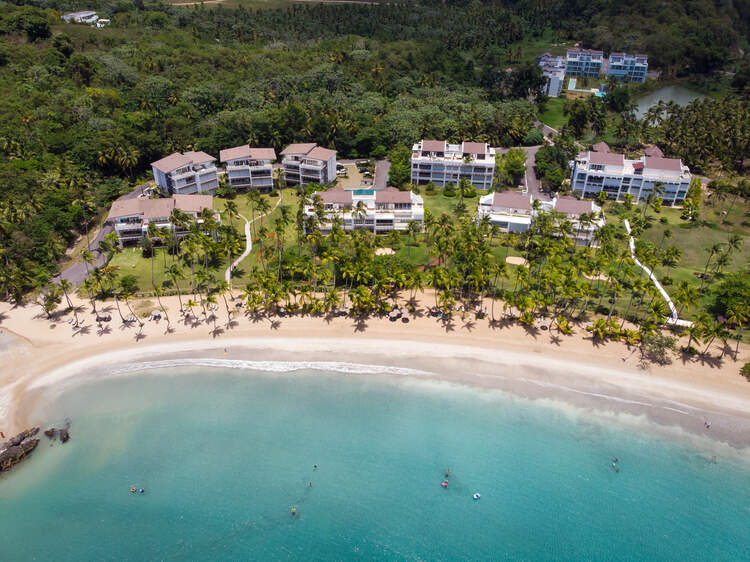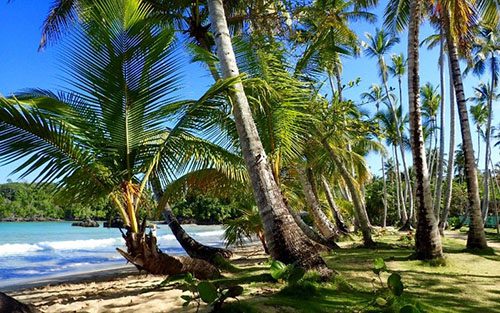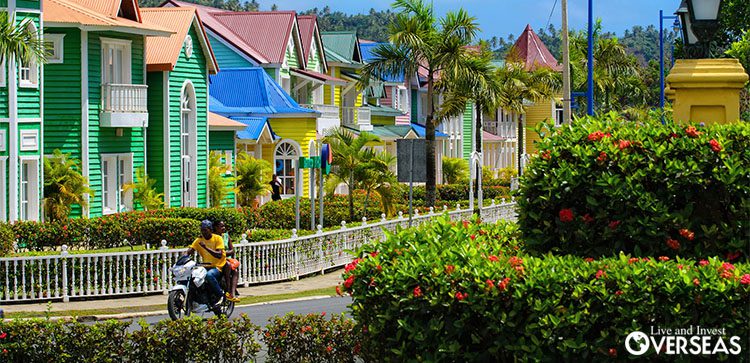A Fatal Social Security Mistake
When Benjmain Franklin wrote, “…in this world nothing can be said to be certain, except death and taxes” few could...
Read moreGet Your Free Dominican Republic Report Today!


Lief Simon is the managing editor of Global Property Advisor, Simon Letter, and Offshore Living Letter. He has purchased more than 45 properties, investing in 23 different countries around the world.
Las Terrenas was discovered in the 1970s by Europeans looking for an affordable Caribbean getaway. Also, they are largely unknown among North Americans.
Today, Las Terrenas is a vibrant international community with residents from all over the globe, including French, German, Polish, Swiss, Italian, Dutch, and British expats.
The eclectic population means you can find exotic food imports from Europe in the supermarkets, freshly made Swiss cheese and German sausage at the local shops, excellent international restaurants, and an active and mixed group of folks to welcome you to their well-established community.
The Caribbean and the sands that fringe it are around every corner in Las Terrenas.
In short, you can easily use the beach as a thoroughfare to get from one part of town to another; it’s the most pleasant pedestrian route.
At any time throughout the day, you can turn this way or that, and there it is again, the sea, now blue, then green.

Las Terrenas is no typical Caribbean beach town. Scratch the surface and you find one of the most interesting expat communities anywhere in the world.
This is a majority French expat population, bolstered by Italians, Brits, Danes, and Germans.
The strong European presence has many implications to do with the way people greet each other in passing, the way they decorate their homes, the way they keep their gardens, the way they pass their free time (pétanque is popular), and, as well, in the local cuisine.
Restaurants in Caribbean beach towns are usually long on jerk chicken and coconut rice, but in las Terrenas expect French and Italian restaurants offering beef carpaccio, homemade pasta, and fresh bread that wouldn’t be out of place in Paris or Tuscany, often supported by wine menus that include many options for fine, even sparkling wine.
Also, in Las Terrenas, you can dine on fried empanadas from a street cart if you’d like (I’d encourage you to try it)… or you can indulge in three- and four-course meals, French or Italian, complemented by good-selection wine lists.
It’s not only the restaurant fare that, until you adjust your expectations, doesn’t quite fit with the geography, but also the service. Wait staff is attentive, competent, reliable… It’s a pleasant surprise.
Other things are surprising, too, including the quality of construction. This is thanks to new hurricane standards being aggressively enforced.
It’s also thanks to the types of developers who have been attracted to this particular Caribbean beach. Not typical gringo developers in the Third World, learning as they go and cutting corners when they can, but experienced developers who boast strong track records.
They’re also European rather than North American. This is evident in the interior finishings.
Tiles, countertops, bathroom fixtures, kitchen cabinets, and furnishings in general are contemporary Euro-chic.
Plus, those early expats in this corner of the Caribbean struggled in the face of an utter lack of infrastructure. You won’t face the same challenges.
The most significant infrastructure development in the region came in 2009 with the Samana-Santo Domingo highway.
It used to take four to six hours to drive from the capital to Las Terrenas, depending on the condition of the meandering dirt road.
Start Your New Life Today, Overseas
Now the drive is a pleasant two hours on a smooth four-lane highway.
This new highway not only made travel easier, but it helped with the overall cost of living in Las Terrenas. Thanks to the improved access, it was easier and cheaper to bring goods into town.
The easy trip to capital city Santo Domingo means you’re never too far from a real city and its shopping, museums, theaters, and stadiums.
Also, Santo Domingo is home to an impressive collection of colonial structures, having been founded by Chris Columbus’ younger brother Bartholomew and then renovated by Diego Columbus (Chris’ eldest son).
This city’s Zona Colonial is a treat for residents and visitors and a major source of tourism income for the country.
Residents of Las Terrenas used to have to travel to Santo Domingo for international air travel. No longer, thanks to the opening of El Catey airport in Las Terrenas, from which regular flights are offered to Canada and the U.S. East Coast (along with plenty of domestic flights).
But while Las Terrenas offers many amenities that other Latin American destinations don’t, don’t make the mistake of thinking that living here will be at all like living back home. It won’t.
And, if you’re up for an adventure, want to get your hands a little dirty, but still like some imported wine and cheese at the end of the day, then this little slice of the Continent in the Caribbean is the perfect spot for you.

Las Terrenas, Dominican Republic, is the best buy in the Caribbean.
In the 70s and 80s, the French were the first group of expats to decide to trade their rough winters for Las Terrenas’ gold-sand beaches.
They started building their own houses, opening businesses and services targeting their fellow expats, and, over the past several decades, have left a significant mark.
Today, Las Terrenas feels like a Euro-chic island outpost. The community is a mix of locals and expats, the latter from France, yes, but many now hail from Italy, Spain, and Germany, and, most recently, from Canada and the United States.
In 2008, a new highway spanning 106 kms from Santo Domingo to the Samaná province was inaugurated. This cut the six-hour journey by car down to two-and-a-half hours and opened up the northern coast of the country.
Today, Las Terrenas, Dominican Republic, has matured to become the main tourist hot spot of the Samaná province.
Most importantly, we’ve long prized the Dominican Republic as our favorite haven in the Caribbean… and, specifically, Las Terrenas for its beautiful beaches, year-round summer temperatures, and welcoming expats.
However, many find that this town’s greatest appeal is its super affordable cost of living.
Start Your New Life Today, Overseas
Las Terrenas, Dominican Republic, offers you a better quality of life.
In the face of inflation and rising costs across the region and the world, the relative bargain prices are more irresistible than ever.
So, just how much will it cost you to retire to the DR?
You could live well here on a budget of as little as US$1,500 a month… or less.
Let’s break it down…
Click here for currency conversion at today’s exchange rate.
The biggest supermarkets in Las Terrenas are Supermercado Lindo and Supermercado Pola. Lindo tends to be more expensive, in part because you can get more imported foods here. Stick to Pola if your budget is tighter.
You should plan on up to US$300 a month. This can be lower if you stick to local brands and fresh foods.
In some cases, your rent will include utilities and internet. In these cases, internet speed and reliability may not be the best. If you work remotely, think about splurging for a faster, better connection.
Most importantly, you could negotiate your rent price, so you can allocate that money for the provider and plan of your choice.
Also, service providers in Las Terrenas include Claro, CV Hotspot, Altece, and Tricom. With Claro, you can get basic internet speed of 5 Mbps for US$30 a month.
An internet speed plan of 10 Mbps to 20 Mbps can cost US$35 a month, while advanced speeds of 40 Mbps to 100 Mbps can cost up to US$100.
On average, a one-bedroom, one-bathroom apartment rents for US$400 to US$700 per month.
A more modern, newer apartment with nicer amenities, furnishings, and finishes will cost you US$600.
A villa goes for US$1,000 monthly, a fully modern three-bedroom villa starts at about US$1,200 monthly.
Rents often include utilities and internet.
Anyone who is not planning to rent but rather to buy a place of their own, need to budget for utilities.
A tank of gas for cooking and hot water costs about US$20 and should last you two or three months.
Also, potable water is provided by the government and a monthly bill can be as little as US$5.
Electricity is notoriously expensive in this country. In Las Terrenas you’ll get your power through a company called Luz y Fuerza at a cost of about US$0.26 per kWh.
For comparison, the average cost per kWh in the United States is US$0.15. Here in Live And Invest Overseas suggest you buy energy-saving appliances, as this makes a real difference in your monthly bill, and using air conditioning sparingly will save considerable money.
The monthly bill without the use of an air conditioner can be about US$60, but could be double that or more if you use air conditioning frequently.
You have dozens of options for eating in restaurants in Las Terrenas. Overall, the price for an entrée with a drink goes from US$15 to US$30 per person.
A lot of dishes can seem overpriced. Unless you are eating at local Dominican eateries, restaurants in Las Terrenas are not as inexpensive.
Overall, you could live with your basic necessities in Las Terrenas for about US$1,300 per month.
Splurging a little more on groceries, a better mobile and internet plan, and eating out in restaurants and bars more than twice a week could raise the cost of living for a couple to US$1,500 to US$2,000 per month.
Las Terrenas, located on the Samaná Peninsula in the Dominican Republic, is a tropical paradise known for its stunning beaches, vibrant culture, and diverse outdoor activities. This charming coastal town has something to offer every type of traveler, from those seeking relaxation on pristine beaches to adventure enthusiasts exploring the natural wonders of the region.
Begin your Las Terrenas adventure by visiting Playa Bonita, a beautiful beach with powdery white sand and turquoise waters. Relax under the swaying palm trees, take a dip in the clear Caribbean Sea, and enjoy the tranquility of this idyllic stretch of coastline.
For instance, you can embark on a journey to the nearby El Limón waterfall, a majestic natural wonder surrounded by lush tropical vegetation. Accessible by horseback or by hiking the Cascada El Limón trail, reaching the waterfall is an adventure in itself. Once there, take a refreshing swim in the cool pool at the base of the falls.
Adventurous nature lovers may also enjoy exploring the natural beauty of the Samaná Peninsula by taking an ATV tour. Ride through lush landscapes, visit hidden beaches, and discover the scenic beauty of the Dominican Republic’s countryside.
Don’t miss the opportunity to go whale watching in Samaná Bay between January and March, . Witness the majestic humpback whales that migrate to the warm waters of the Caribbean to mate and give birth.
But for those who would rather play in the water than watch it, luckily Las Terrenas is a haven for water sports enthusiasts. The consistent trade winds make it an ideal spot for kitesurfing and windsurfing. Several schools and rental facilities along the beaches offer lessons for beginners and equipment for experienced riders.
You could also take a boat trip to Cayó Levantado, also known as Bacardi Island. This postcard-perfect island boasts palm-fringed beaches, clear waters, and a relaxed atmosphere. It’s an excellent spot for snorkeling, sunbathing, and enjoying the beauty of the Caribbean.
Also, to enjoy the local atmosphere, try strolling through Pueblo de los Pescadores, the town’s charming fisherman’s village. This area is lined with colorful wooden buildings, beachfront restaurants, and shops. It’s a great place to experience the local culture and cuisine.
You could explore the neighboring town of Las Galeras, known for its pristine beaches and laid-back atmosphere. Playa Rincon, one of the most famous beaches in the area, is a must-visit for its uncrowded shores and crystal-clear waters.
But as the sun sets, Las Terrenas comes alive with vibrant nightlife. Just make sure you’re home in time to explore the beachfront bars, restaurants, and clubs offering live music, dance, and a lively atmosphere. Pueblo de los Pescadores is a particularly popular area for nighttime entertainment.
Start Your New Life Today, Overseas
For those just looking to explore Las Terrenas before making a move, luckily Americans can enter the Dominican Republic without a visa and can stay for up to 30 days for tourist purposes.
It’s possible to receive an extension for another 30 days if you like your trip so much, but for any longer period of time you will need a visa.
One of the most popular visa options for Americans is the Residence Visa for Rentiers and Retirees (Residencia para Rentistas y Pensionados). This visa is designed for individuals with a stable income, such as retirees or those with sufficient financial means. Applicants must demonstrate a regular monthly income or pension, and the visa allows for a more extended stay in the country.
However, if you already have family in the Dominican Republic, your best option might be to acquire the Residence Visa for Family Reunification (Residencia por Reunificación Familiar).
Family members of Dominican citizens or residents can apply for this visa to join their relatives in the country, but the sponsoring family member must provide the necessary documentation for the application.
Another possible option is the Residence Visa for Investors (Residencia para Inversionistas) for those making significant investments in the Dominican Republic, such as starting a business or purchasing real estate. This visa offers immediate permanent residency and a two-year path to citizenship for those who invest at least US$200,000 n the country, as outlined by Dominican immigration authorities.
There are also work (Residencia para Trabajo) and student (Visa de Estudiante) visas available for those who have proof of a job offer or admission into a university in the Dominican Republic.
There is even the Residence Visa for Temporary Workers (Residencia Temporal para Trabajadores), for those who are not planning to establish permanent residency. Potential applicants with special skills might also look into the Residence Visa for Cultural, Scientific, and Sports Activities (Residencia para Actividades Culturales, Científicas y Deportivas), as artists, scientists, and athletes participating in cultural, scientific, or sports activities in the Dominican Republic can apply for this visa.
Just make sure to start your visa application process well ahead of your planned move, and to direct any questions to the Dominican embassy/consulate or a legal representative.
Las Terrenas is located in the Samaná Province on the east coast of the Dominican Republic, and contains the Sierra de Samaná mountain range as well as numerous beaches. Its geography contributes to its tropical rainforest climate, so naturally Samaná sees lots of rain– precipitation can exceed 2,500 mm per year, particularly in the rainy season between May and November.
Otherwise, Las Terrenas enjoys year-round warm (and occasionally humid) weather. In the winter months between December and February the average temperature is between 68°F to 77°F, and in the summer months between June and August and September to November the average temperature is between 77°F and 81°F.
With weather so consistently nice there’s not necessarily a bad time to visit Las Terrenas, but just be prepared for rain and potential meteorological phenomena if traveling within hurricane season. Just be aware that the Dominican Republic falls on the Atlantic hurricane belt, and cyclones, hurricanes, and tropical storms can occur between August to October.
The Dominican Republic is well known for its gorgeous golf courses and stunning beaches, along with the tallest mountain peak, lowest elevation point, and largest lake in the Caribbean.
Las Terrenas is an excellent place for those who wish to retire amongst the Dominican Republic’s beautiful white beaches and lush forests, while also enjoying the familiar amenities of Western life. With easily attainable visa options, an affordable cost of living, and a quieter pace of life, many retirees choose to move to Las Terrenas newer developments on the northeastern coast.
Many Americans move to Las Terrenas because there they can affordably fulfill their dreams of relaxing on the white beaches of the Caribbean while not losing the comforts of home. Residents feel welcomed by Las Terrenas’ large expat community and modern Western developments, which are alluring to those who may want a change in scenery but don’t want to break the bank. In short, to enjoy life overseas.
The Dominican Republic is an outdoor lover’s paradise, with an average daily temperature of 78.8°F (26°C). Also, the country’s biological diversity ranges from tropical rainforests to tropical savannas.
When Benjmain Franklin wrote, “…in this world nothing can be said to be certain, except death and taxes” few could...
Read moreWhen Benjmain Franklin wrote, “…in this world nothing can be said to be certain, except death and taxes” few could...
Read more"I've had enough of your Caribbean vacations for this year!" This is the response Bill Piatt got from his wife...
Read moreThe best countries for Canadians to retire to are mostly well-known to Canadians. Expats can be found, usually close to the beach, in all the countries we mention here. Ask most of them why they moved and you will usually hear two main reasons. The first is the weather. Lots of Canadians choose a part-time retirement in the sun to escape the brutal winters. Leaving before the first snow and returning after the thaw has set in allows you to...
Read moreGet Your Free Dominican Republic Report Today!

© 2008 - 2024 Live and Invest Overseas - All Rights Reserved.
Sign up for FREE and learn how to live the good life on a modest budget, find bargain property, and more. Plus, check out our free report on the 10 BEST PLACES TO RETIRE.
RETIRE OVERSEAS AND LIVE LIKE ROYALTY
Sign up to receive the FREE daily e-letter, Overseas Opportunity Letter and we’ll immediately email you our editors’ latest research report…
RETIRE OVERSEAS AND LIVE LIKE ROYALTY
© 2008 - 2024 Live and Invest Overseas - All Rights Reserved.